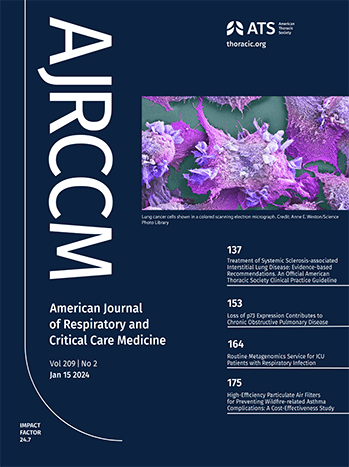肺结节病中颗粒物质与肺功能的关系。
IF 19.4
1区 医学
Q1 CRITICAL CARE MEDICINE
American journal of respiratory and critical care medicine
Pub Date : 2025-06-18
DOI:10.1164/rccm.202410-1925oc
引用次数: 0
摘要
理由:结节病是一种多系统疾病,90%以上的患者以肺部表现。环境暴露与结节病发病率有关,但对临床结果的影响仍未得到充分研究。目的:评估≤2.5µm (PM2.5)环境颗粒物暴露与肺结节病肺功能结局的关系。方法:通过将每月卫星衍生的混合测量值与每位患者从入组时获得的居住地址进行匹配,获得PM2.5和成分暴露,平均为登记入组/审查前的5年。线性模型评估了污染物与基线肺功能(用力呼气量,FEV1;强制肺活量;FEV1 / FVC的;一氧化碳扩散能力(DLCO)。线性混合效应模型分析了污染物与肺功能变化率(每年随访的FEV1、FVC、DLCO变化)的关系。测量方法和主要结果:两个前瞻性纳入的队列主要是中年,白人和非吸烟的成年人,经专家诊断为肺结节病。与加拿大队列(n=112)(8.0µg/m3)相比,美国队列(n=400)的5年入组前PM2.5暴露中位数(12.3µg/m3)更高。在美国队列中,PM2.5每增加1µg/m3, 0.93%预测基线FEV1降低(95% CI -1.76至-0.10,p=0.03), 1.53%预测FVC降低(95% CI -2.26至-0.79,p<0.001),但在加拿大队列中,相关性不显著。在美国队列中,PM2.5、硫酸盐、硝酸盐和铵与FEV1、FVC和DLCO的加速下降有关。结论:在高暴露队列中,PM2.5与更严重的肺部疾病严重程度和进展相关,突出了该人群暴露差异的重要性。本文章由计算机程序翻译,如有差异,请以英文原文为准。
Particulate Matter Associations with Lung Function in Pulmonary Sarcoidosis.
Rationale: Sarcoidosis is a multi-system disease with pulmonary manifestations in over 90% of patients. Environmental exposures are associated with sarcoidosis incidence, but the impact on clinical outcomes remains understudied. Objectives: To evaluate the association of ambient particulate matter ≤2.5µm (PM2.5) exposures with lung function outcomes in pulmonary sarcoidosis. Methods: PM2.5 and constituent exposures were obtained by matching monthly satellite-derived hybrid measurements to each patient's residential address obtained from time of enrollment, averaged over 5-years before registry enrollment/censoring. Linear models evaluated associations of pollutants with baseline lung function (forced expiratory volume, FEV1; forced vital capacity, FVC; FEV1/FVC; diffusing capacity for carbon monoxide, DLCO). Linear mixed effects models analyzed associations of pollutants with rate of lung function change (FEV1, FVC, DLCO change per year of follow-up). Measurements and Main Results: Two prospectively enrolled cohorts of mostly middle-aged, White and non-smoking adults with specialist-diagnosed pulmonary sarcoidosis were used. The U.S. cohort (n=400) experienced higher 5-year pre-enrollment median PM2.5 exposures (12.3µg/m3) compared to the Canadian cohort (n=112) (8.0µg/m3). Each 1µg/m3 increase in PM2.5 was associated with 0.93% predicted lower baseline FEV1 (95% CI -1.76 to -0.10, p=0.03) and 1.53% predicted lower FVC (95% CI -2.26 to -0.79, p<0.001) in the U.S. cohort, but associations were not significant in the Canadian cohort. PM2.5, sulfate, nitrate, and ammonium were associated with accelerated FEV1, FVC, and DLCO decline in the U.S. cohort. Conclusions: PM2.5 was associated with worse pulmonary disease severity and progression in a higher-exposure cohort, highlighting the importance of exposure disparities in this population.
求助全文
通过发布文献求助,成功后即可免费获取论文全文。
去求助
来源期刊
CiteScore
27.30
自引率
4.50%
发文量
1313
审稿时长
3-6 weeks
期刊介绍:
The American Journal of Respiratory and Critical Care Medicine focuses on human biology and disease, as well as animal studies that contribute to the understanding of pathophysiology and treatment of diseases that affect the respiratory system and critically ill patients. Papers that are solely or predominantly based in cell and molecular biology are published in the companion journal, the American Journal of Respiratory Cell and Molecular Biology. The Journal also seeks to publish clinical trials and outstanding review articles on areas of interest in several forms. The State-of-the-Art review is a treatise usually covering a broad field that brings bench research to the bedside. Shorter reviews are published as Critical Care Perspectives or Pulmonary Perspectives. These are generally focused on a more limited area and advance a concerted opinion about care for a specific process. Concise Clinical Reviews provide an evidence-based synthesis of the literature pertaining to topics of fundamental importance to the practice of pulmonary, critical care, and sleep medicine. Images providing advances or unusual contributions to the field are published as Images in Pulmonary, Critical Care, Sleep Medicine and the Sciences.
A recent trend and future direction of the Journal has been to include debates of a topical nature on issues of importance in pulmonary and critical care medicine and to the membership of the American Thoracic Society. Other recent changes have included encompassing works from the field of critical care medicine and the extension of the editorial governing of journal policy to colleagues outside of the United States of America. The focus and direction of the Journal is to establish an international forum for state-of-the-art respiratory and critical care medicine.

 求助内容:
求助内容: 应助结果提醒方式:
应助结果提醒方式:


